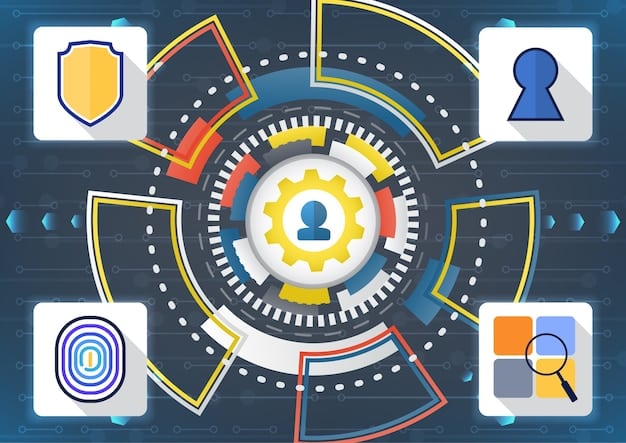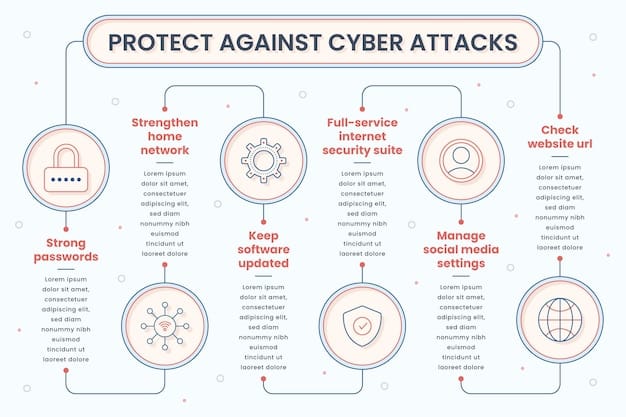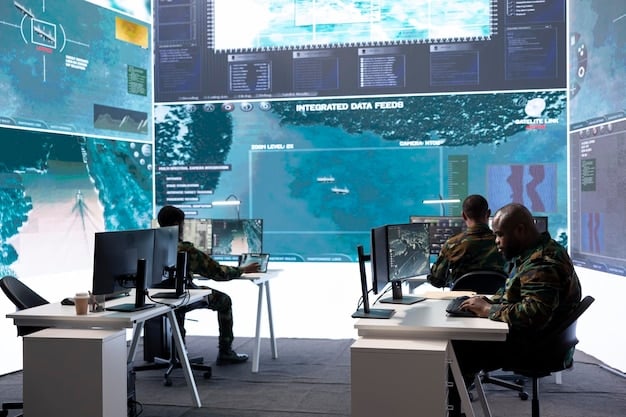NIST Cybersecurity Framework: A 6-Step Implementation Guide

The NIST Cybersecurity Framework (CSF) is a voluntary framework that provides a structured approach for organizations in the US to manage and reduce cybersecurity risks by understanding, assessing, and improving their cybersecurity posture through a set of standards, guidelines, and best practices.
In today’s digital landscape, robust cybersecurity measures are essential for protecting sensitive data and ensuring business continuity. The Cybersecurity Guide: Understanding and Implementing the NIST Cybersecurity Framework in 6 Steps provides a proven methodology for organizations to establish and maintain a strong security posture against evolving threats.
Understanding the NIST Cybersecurity Framework
The NIST Cybersecurity Framework (CSF) is a set of guidelines and best practices designed to help organizations manage and reduce cybersecurity risks. Developed by the National Institute of Standards and Technology (NIST), the CSF provides a structured approach to cybersecurity, enabling organizations to understand, assess, and improve their cybersecurity posture.
The framework is not a one-size-fits-all solution but rather a flexible and adaptable tool that can be tailored to meet the specific needs and risks of any organization, regardless of size or industry. It focuses on business outcomes and integrates cybersecurity into overall risk management.
Key Components of the NIST CSF
The NIST CSF is comprised of three main components that work together to create a comprehensive cybersecurity framework:
- Framework Core: This is the heart of the CSF and consists of five concurrent and continuous Functions: Identify, Protect, Detect, Respond, and Recover. These Functions represent the lifecycle of cybersecurity management.
- Implementation Tiers: These tiers describe the degree to which an organization’s cybersecurity risk management practices exhibit the characteristics defined in the Framework. The tiers range from Partial (Tier 1) to Adaptive (Tier 4).
- Framework Profiles: Profiles represent an organization’s unique alignment of its requirements and objectives, its risk appetite, and its resources against the desired outcomes of the Framework Core.
The CSF emphasizes a risk-based approach, meaning that organizations should prioritize their cybersecurity efforts based on the potential impact on their business objectives. This involves identifying critical assets, understanding potential threats and vulnerabilities, and implementing appropriate controls to mitigate those risks.

In conclusion, understanding the NIST Cybersecurity Framework involves grasping its structure, the five core Functions, Implementation Tiers, and Framework Profiles. This understanding provides the foundation for effectively managing and reducing cybersecurity risks within an organization.
Step 1: Identify – Understanding Your Cybersecurity Landscape
The “Identify” Function is the cornerstone of the NIST Cybersecurity Framework. It involves developing an organizational understanding to manage cybersecurity risk to systems, assets, data, and capabilities. Without a clear understanding of your environment, it’s impossible to effectively protect it.
This function is about knowing what you have, where it is, and how critical it is to your organization’s operations. It’s about establishing a clear picture of your cybersecurity landscape.
Asset Management
Identifying and documenting all assets, including hardware, software, data, and personnel, is a fundamental aspect of the Identify Function.
- Hardware Inventory: Maintain a detailed inventory of all hardware assets, including servers, workstations, network devices, and mobile devices.
- Software Inventory: Track all software applications, operating systems, and security tools deployed within the organization.
- Data Classification: Classify data based on its sensitivity and criticality to the organization, ensuring that sensitive data is appropriately protected.
Business Environment
Understanding the organization’s mission, objectives, and activities is essential for prioritizing cybersecurity efforts. This involves identifying critical business functions and the assets that support them.
- Business Impact Analysis: Conduct a business impact analysis to identify the potential impact of cybersecurity incidents on critical business functions.
- Risk Assessment: Assess the likelihood and impact of potential cybersecurity threats and vulnerabilities.
- Compliance Requirements: Identify and comply with all relevant legal, regulatory, and contractual obligations related to cybersecurity.
The Identify Function is a continuous process that requires ongoing monitoring and updating to reflect changes in the organization’s environment and risk landscape. This foundational step sets the stage for implementing effective security controls and mitigating potential risks.
Step 2: Protect – Implementing Safeguards
The “Protect” Function focuses on developing and implementing appropriate safeguards to ensure the delivery of critical infrastructure services. This involves implementing security controls to protect assets, data, and systems from potential threats.
This function is about building your defenses and putting measures in place to prevent cybersecurity incidents from occurring. It encompasses a wide range of security controls and practices.
Access Control
Limiting access to sensitive data and systems is a critical aspect of the Protect Function. This involves implementing strong authentication mechanisms and enforcing the principle of least privilege.
- Multi-Factor Authentication: Implement multi-factor authentication (MFA) for all critical systems and applications to prevent unauthorized access.
- Role-Based Access Control: Assign access privileges based on job roles and responsibilities, ensuring that users only have access to the resources they need.
- Regular Access Reviews: Conduct regular access reviews to ensure that user access privileges are appropriate and up-to-date.
Data Security
Protecting sensitive data from unauthorized access, use, disclosure, disruption, modification, or destruction is paramount. This involves implementing data encryption, data loss prevention (DLP) measures, and secure data storage practices.
- Data Encryption: Encrypt sensitive data both in transit and at rest to protect it from unauthorized access.
- Data Loss Prevention (DLP): Implement DLP measures to prevent sensitive data from leaving the organization’s control.
- Secure Data Storage: Store sensitive data in secure locations with appropriate access controls and backup procedures.
The Protect Function also includes implementing security awareness training for employees, establishing security policies and procedures, and implementing physical security controls. These safeguards work together to minimize the likelihood and impact of cybersecurity incidents.
Step 3: Detect – Monitoring for Security Events
The “Detect” Function focuses on developing and implementing appropriate activities to identify the occurrence of a cybersecurity event. This involves establishing monitoring systems and processes to detect anomalies, intrusions, and other security incidents.
This function is about having the capability to identify when something goes wrong and to know when your defenses have been breached. It requires proactive monitoring and analysis of security events.
Security Information and Event Management (SIEM)
Implementing a SIEM system is essential for collecting, analyzing, and correlating security logs from various sources. This enables organizations to identify suspicious activity and potential security incidents.
- Log Collection: Collect security logs from servers, workstations, network devices, and security appliances.
- Log Analysis: Analyze security logs for suspicious patterns, anomalies, and indicators of compromise.
- Alerting: Configure alerts to notify security personnel of potential security incidents.
Intrusion Detection and Prevention Systems (IDPS)
Deploying IDPS solutions can help detect and prevent malicious activity on the network and endpoints. These systems monitor network traffic and system activity for suspicious patterns and known threats.
- Network Intrusion Detection: Monitor network traffic for malicious activity and known attack signatures.
- Host-Based Intrusion Detection: Monitor system activity for suspicious behavior and indicators of compromise.
- Intrusion Prevention: Block or mitigate detected threats in real-time.

The Detect Function also includes vulnerability scanning, penetration testing, and incident triage processes. These activities help organizations identify and respond to security incidents in a timely manner.
Step 4: Respond – Taking Action on Detected Incidents
The “Respond” Function focuses on developing and implementing appropriate activities to take action regarding a detected cybersecurity incident. This involves establishing incident response plans, coordinating response efforts, and mitigating the impact of the incident.
This function is about having a plan in place to deal with cybersecurity incidents and being able to execute that plan effectively. It requires coordination, communication, and decisive action.
Incident Response Plan
Developing a comprehensive incident response plan is crucial for guiding the organization’s response to cybersecurity incidents. The plan should outline roles and responsibilities, communication protocols, and procedures for containment, eradication, and recovery.
- Incident Identification: Define the criteria for identifying and classifying security incidents.
- Containment: Implement measures to contain the spread of the incident and prevent further damage.
- Eradication: Remove the root cause of the incident and eliminate any remaining threats.
Communication
Establishing clear communication channels is essential for coordinating response efforts and keeping stakeholders informed. This involves establishing communication protocols, designating communication responsibilities, and maintaining open lines of communication with internal and external stakeholders.
- Internal Communication: Keep employees informed of the incident and any necessary actions they need to take.
- External Communication: Communicate with customers, partners, and regulatory agencies as appropriate.
- Law Enforcement: Coordinate with law enforcement agencies in the event of a significant cybersecurity incident.
The Respond Function also includes post-incident analysis and lessons learned. This helps organizations identify areas for improvement and prevent similar incidents from occurring in the future.
Step 5: Recover – Restoring Capabilities and Services
The “Recover” Function focuses on developing and implementing appropriate activities to maintain plans for resilience and to restore any capabilities or services that were impaired due to a cybersecurity incident. This involves restoring systems, data, and operations to their normal state.
This function is about getting back to normal operations after a cybersecurity incident and ensuring that the organization can continue to function effectively. It requires planning, coordination, and resilience.
Recovery Planning
Developing a recovery plan is essential for restoring systems, data, and operations to their normal state. The plan should outline procedures for data recovery, system restoration, and business continuity.
- Data Backup and Restoration: Implement regular data backups and test the restoration process to ensure data can be recovered in the event of a data loss incident.
- System Restoration: Establish procedures for restoring systems to their normal operating state, including reimaging servers and workstations.
- Business Continuity: Implement business continuity plans to ensure that critical business functions can continue to operate during and after a cybersecurity incident.
Communication
Maintaining open communication channels is essential for keeping stakeholders informed during the recovery process. This involves communicating progress updates, addressing concerns, and coordinating efforts with internal and external stakeholders.
- Internal Communication: Keep employees informed of the recovery process and any necessary actions they need to take.
- External Communication: Communicate with customers, partners, and regulatory agencies as appropriate.
The Recover Function also includes post-recovery testing and validation. This ensures that systems and data have been successfully restored and that the organization is back to its normal operating state.
Step 6: Continuous Improvement and Adaptation
Implementing the NIST Cybersecurity Framework is not a one-time event but rather an ongoing process of continuous improvement and adaptation. This involves regularly assessing the organization’s cybersecurity posture, identifying areas for improvement, and adapting security controls to address evolving threats.
This step is about embracing a culture of continuous learning and improvement and ensuring that the organization’s cybersecurity efforts remain effective over time.
Regular Assessments
Conducting regular assessments of the organization’s cybersecurity posture is essential for identifying areas for improvement. This involves vulnerability scanning, penetration testing, security audits, and risk assessments.
- Vulnerability Scanning: Identify and remediate vulnerabilities in systems and applications.
- Penetration Testing: Simulate real-world attacks to identify weaknesses in the organization’s security defenses.
- Security Audits: Conduct independent audits to assess the effectiveness of security controls.
Threat Intelligence
Staying informed about the latest threats and vulnerabilities is crucial for adapting security controls to address evolving threats. This involves monitoring threat intelligence feeds, participating in industry forums, and sharing information with other organizations.
- Threat Monitoring: Monitor threat intelligence feeds for new threats and vulnerabilities.
- Information Sharing: Share threat information with other organizations and participate in industry forums.
Continuous improvement and adaptation are essential for maintaining a strong cybersecurity posture and protecting against evolving threats.
| Key Point | Brief Description |
|---|---|
| 🔑 Identify Assets | Understand and document all assets, including hardware, software, and data. |
| 🛡️ Implement Safeguards | Implement security controls to protect assets and systems from threats. |
| 🚨 Detect Incidents | Monitor for suspicious activity and potential security incidents. |
| 🚀 Respond and Recover | Take action on detected incidents and restore impaired capabilities. |
Frequently Asked Questions
▼
The NIST CSF is a voluntary framework that provides a structured approach for organizations to manage and reduce cybersecurity risks based on existing standards, guidelines, and best practices.
▼
The NIST CSF is designed for any organization, regardless of size or industry, that wants to improve its cybersecurity posture and manage cybersecurity risks effectively.
▼
The five core Functions are Identify, Protect, Detect, Respond, and Recover. These Functions represent the lifecycle of cybersecurity management.
▼
You should regularly assess and update your NIST CSF implementation to adapt to evolving threats and changes in your organization’s environment. Continuous improvement is key.
▼
The NIST CSF is a voluntary framework, but it can help organizations meet legal and regulatory requirements related to cybersecurity by providing a structured approach to risk management.
Conclusion
Implementing the NIST Cybersecurity Framework is a strategic imperative for organizations seeking to enhance their cybersecurity resilience. By following these six steps—Identify, Protect, Detect, Respond, Recover, and Continuous Improvement—organizations can establish a robust security posture, mitigate risks, and safeguard their critical assets in an ever-evolving threat landscape.





